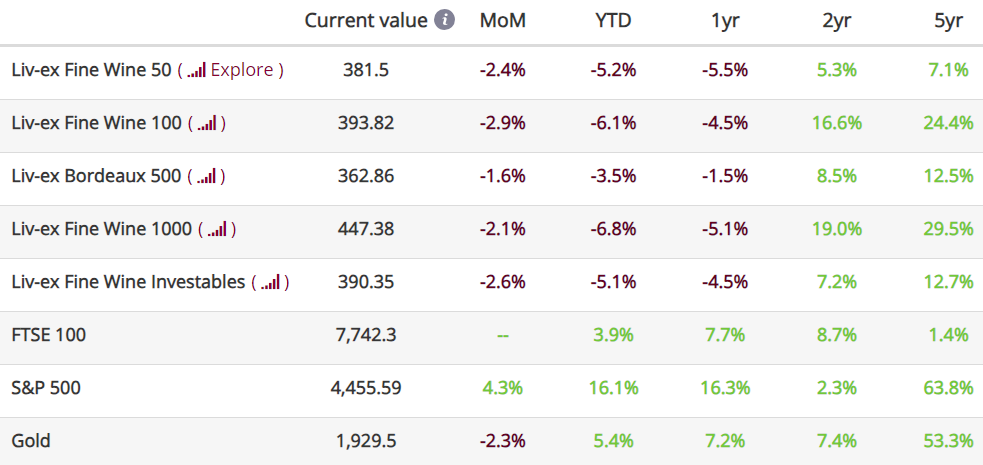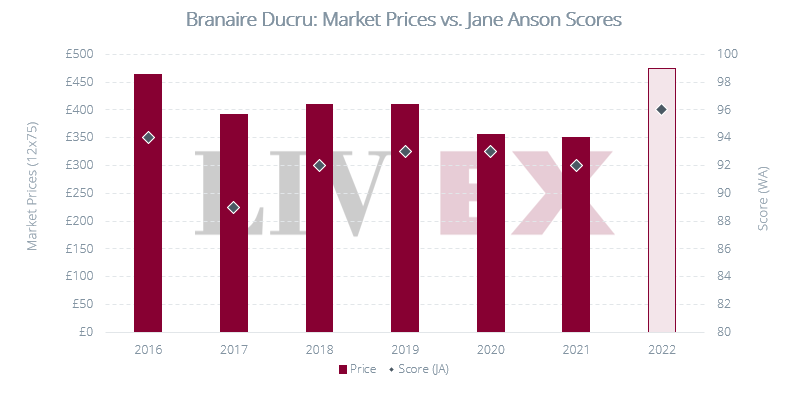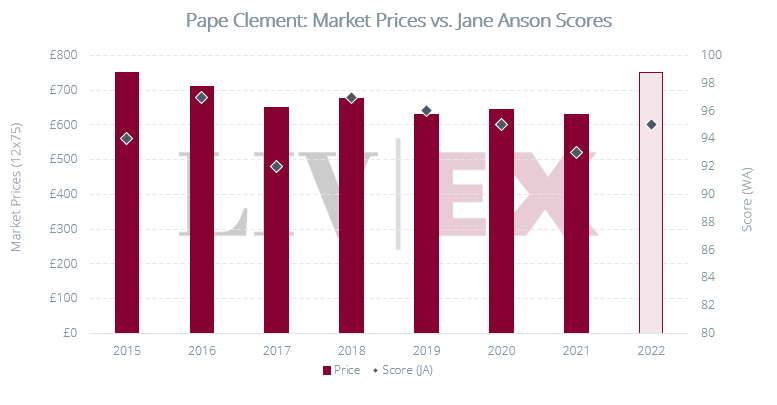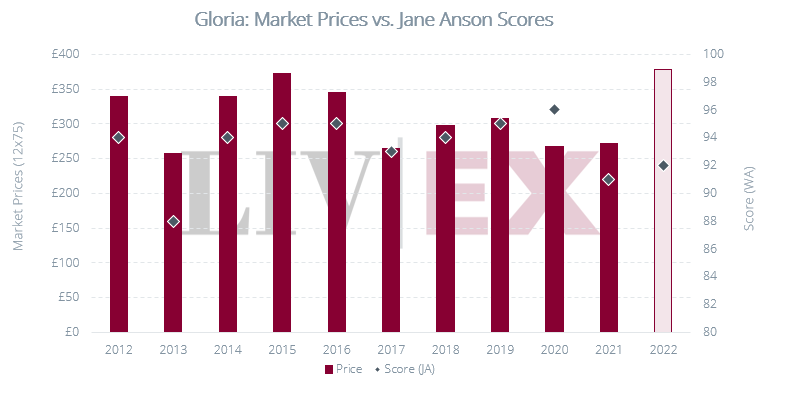July Market Report
Share this article | Print this article
- All the major Liv-ex indices continued to fall in June
- Barsac wines remained the top-performing wines
- Technical Analysis of Cos d’Estournel 2010
- Jane Anson’s top 30 great value Bordeaux 2022
A buyer’s market
*data taken on July 5th 2023.
Last month was a further month of downturns, with all major Liv-ex indices falling. The Liv-ex Fine Wine 100, the industry benchmark, was down 2.9% from the previous month to close at 393.82 and the Liv-ex Fine Wine 50 (which tracks the movement of First Growths) fell by 2.4% month-on-month. Year-to-date, the picture is much the same: all indices are down, most notably the Liv-ex Fine Wine 1000 which fell 2.1% last month but is down 6.8% since the start of 2023.
Unlike in May, trade value and volume were both down on Liv-ex in June, as was the number of individual labels (LWIN11s) traded on the platform. Of the wines that make up the Liv-ex Fine Wine 100, 79 saw their price fall over the last month*. The En Primeur 2022 campaign, which came to a close last week, did not do much to improve market sentiment, as many were deterred by the considerable price increases implemented by châteaux.
Prices falling across the board mean it is very much a buyer’s market at the moment. Active bidders may well be rewarded, as may sellers pricing their stock wisely. Various sections in this report highlight the importance of the secondary market in this risk-averse climate; savvy collectors can use it to spot opportunities and make the most of the situation.
* Liv-ex members can see price movements of individual wines in the LX100 in-app using the Indices Explorer.
Major Market Movers
Barsac continues its strong price performance
The Liv-ex Fine Wine 1000 is down 2.1% month-on-month, slightly less than in May (-2.4%).
Interestingly, the index’s top performers were once again from Barsac. Prices for back vintages of Château Climens and Château Coutet kept rising last month, buoying the Liv-ex Fine Wine 1000 alongside some Burgundian wines.
* All Liv-ex indices are calculated using our Mid Price; the mid-point between the highest live bid and lowest live offer on the market. These are the firm commitments to buy and sell at that price; transactional data rather than list prices. It represents the actual trading activity of over 630 of the world’s leading fine wine merchants. Because Liv-ex doesn’t itself trade, this data is truly independent and reliable.
Château Climens 2010 was once again one of the top price performers, its Mid Price rising by 26.6% month-on-month. The 2012 and 2009 vintages of Climens also featured among the top ten performers in the Liv-ex Fine Wine 1000, their Mid Prices rising 24.1% and 16.1% respectively.
The 2018 and 2014 vintages of Château Coutet also saw double-digit growth, rising 13.8% and 10.7% month-on-month.
The strong performance of wines from Barsac could be attributed to the lack of availability of wines from the region. Production in the region has been severely affected by weather conditions in the past decade, with many estates not releasing wines in some years. As a result, the market for those wines is quite illiquid, and demand pushes prices up.
The 2022 releases of Château Coutet and Château Barsac are among the most expensive on the market compared previous releases, which may also explain the increasing prices of back vintages, as buyers searching for value may turn to physical wines.
Chart of the Month
Technical Analysis of Cos d’Estournel 2010
What is technical analysis?
Technical analysis is a method of forecasting future movements by looking back, the theory being that historical trading activity can be a valuable indicator of its future price movements.
Back to the release price
The Market Price of Cos d’Estournel 2010 stood at £2,177 on the 30th of June 2023, the same price it was trading at in 2011 upon its release En Primeur. A 40% price drop in the four years post-release was followed by a sharp move up in 2015 and 2016, a consolidation phase from 2016 to mid-2020, and another bull market printing an all-time high (ATH) at £2,340 in October 2022.
The Relative Strength Index (RSI) reached a high in January 2022 and started declining thereafter while the price continued its ascent beyond the 2,175 horizontal resistance turned support level. This resulted in an extended bearish divergence and a sell signal in early March 2023 when the RSI crossed below the ’70 line’.
Will the strong convergence zone provide support?
The current short-term bearish trend from the ATH was first confirmed by the break of the rising accelerated trendline, quickly followed by the break of the 7-month Simple Moving Average (SMA). Cos d’Estournel 2010’s price subsequently also broke its 20-month SMA in May 2023, and is now hovering around an important convergence zone: the horizontal support from 2011, the 23.6% Fibonacci retracement, and another potential accelerated trendline just below. It remains to be seen whether this support zone will hold.
What to look out for
Should the convergence zone currently supporting the price be broken down, we will closely watch the price action around the 38.2% and 50% Fibonacci levels, and, should it reach that point, the SMA(50), which is expected to preserve the longer-term bullish trend from 2015. Should the price bounce off the convergence zone, we will then monitor whether it can re-take its SMA(7) and (20). If they were to act as resistance in the next few months and push the price back below the convergence zone, we could see a head and shoulders pattern form, with a target price of £2,014.
Critical Corner
Jane Anson’s top 30 great value Bordeaux 2022
Cutting through the overwhelming negativity of the 2022 En Primeur campaign, wine critic Jane Anson (Inside Bordeaux) recently published a list of her top 30 value picks from this excellent vintage. According to her, the wines chosen ‘offer exceptional value against their peers’, and as such come at a variety of price points.
Below, we’ve assessed some of the critics’ choices against their back vintages, using our Fair Value methodology where applicable.
Château Brane-Cantenac 2022 was released at £720 per 12×75, €60 per bottle ex-négociant. Jane Anson scored it 98 points, calling it ‘easily one of the best wines of the appellation’. While this is the highest-rated vintage in the last seven years according to the critic, it’s also the most expensive in comparison to previous vintages.
The 2015, which was rated two points less, can be purchased at a 16.7% discount to the 2022 release. It is already physical and benefits from a number of years in bottle, making it a compelling option for those seeking a more affordable choice.
Château Gruaud Larose 2022 was released at £840 per 12×75, €69.60 per bottle ex-négociant. Jane Anson scored it 96 points, acknowledging its ’excellent quality’.
However, in terms of value, the 2019 vintage surpasses the 2022 release. It received a higher score of 97 points from Jane Anson and is available at a discount of 22.0% compared to the release price of the 2022 vintage. Unlike the latest release, it is also already physical.
Château Branaire-Ducru 2022 was released at £474 per 12×75, €39.60 per bottle ex-négociant. Jane Anson scored it 96 points, stating that it is ‘honestly the best example of this château that I have ever tasted En Primeur’. This vintage boasts the highest score from the critic in the last seven years.
Branaire-Ducru prices are 58.2% correlated to Jane Anson scores. The chart below shows the 2022 vintage falls just before the trendline, meaning it is offered at fair value. As such, it is a good buying option compared to its back vintages.
The next closest-scoring vintage is the 2016, which received 94 points and is available at a modest discount of 2.3% compared to the 2022 release. However, if scores are less important, the lower-scoring 2020 can be purchased at a discount of 24.9% compared to the 2022 release price, offering an attractive option for those looking for a more affordable entry point into the label.
Château Léoville Barton 2022 was released at £780 per 12×75, €64.20 per bottle ex-négociant. Jane Anson scored it 96 points, describing the wine as ‘balanced, elegant, built to last’.
The 2022 vintage offers relative value compared to the 2016 vintage, which has the same score from the critic but is available at a considerable markup of 34.6%. That said, the 2016 is physical and already benefits from a few years in bottle.
Buyers may want to consider the higher-scoring 2018 and 2019 vintages, which were both rated 97 points and are available at discounts of 11.5% and 1.3% to the latest release respectively.
Château Pape Clément 2022 was released at £750 per 12×75, €62.40 per bottle ex-négociant. Jane Anson scored it 95 points, highlighting its ‘clear sense of future potential, with plenty of complexity. Rises to meet the vintage, not overpowered by it. Will age well’.
The 2022 release is not the highest-scoring vintage of the past seven years, but it is the most expensive on the market. As such, buyers seeking better value may want to consider the 97-point 2018 and 2016 vintages, the highest scoring of the last seven vintages according to Jane Anson. They can be purchased at discounts of 9.7% and 5.3% to the 2022 respectively.
The 2020 vintage received 95 points and is available at a discount of 14.3% compared to the 2022 release price. The 96-point 2019 vintage can be acquired at an even higher discount of 16%.
Pichon Comtesse Réserve 2022 was released at £432 per 12×75, €36 per bottle ex-négociant. Jane Anson scored it 93 points, calling it ‘an impressive wine’. Among the wine’s back vintages, the 2019 stands out as it shares the same score as the 2022 release while being available at a discount of 25.9%.
Château Gloria 2022 was released at £378 per 12×75, €31.20 per bottle ex-négociant. Jane Anson scored it 92 points, calling it ‘one to watch over ageing’.
While Anson’s observation holds promise for the future, the 2022 vintage is currently one of the most expensive Gloria vintages on the market and also one of the lowest-scoring of the last decade. Buyers seeking value have numerous alternatives to consider including the 2020 vintage, which received a score of 96 points and is available at a discount of 29.4% compared to the 2022 release. Similarly, the 2019 vintage, scoring 95 points, and the 2018 vintage, scoring 94 points, are available at discounts of 18.5% and 21.4% respectively. These higher-scoring vintages at more attractive price points offer compelling options for discerning buyers.
News Insight
Domaine Arnoux-Lachaux goes direct-to-consumer
Famed Burgundy estate Domaine Arnoux-Lachaux has signed an exclusive direct-to-consumer distribution deal with Crurated. The platform was launched in 2021 and aims to connect collectors with producers directly, encoding provenance information in blockchain technology.
Domaine Arnoux-Lachaux wines will be sold exclusively to consumers through Crurated, and B2B sales will be handled by distributors. ‘The aim of this distribution is to have consumption’, Lachaux told the drinks business. ‘We use Crurated as a tool to supply more individuals across the world’. Is the introduction of this direct-to-consumer model the way to broaden access to these wines? Does the traditional model of merchants championing producers’ wines no longer work?
Crurated has made a collection of Arnoux-Lachaux 2020 wines available to its members through an auction which took place in June. The minimum offer for the lot of six bottles including Bourgogne Pinot Fin 2020, Nuits-Saint-Georges 2020, Nuits-Saint-Georges Les Poisets 2020, Nuits-Saint-Georges Premier Cru Clos des Corvées Pagets 2020, Vosne-Romanée Premier Cru les Chaumes 2020 and Vosne-Romanée Premier Cru Les Grand Suchots 2020 was listed at €6,000. This does not include taxes or the €600 monthly membership fee required to even bid on the lot.
By contrast, the same selection of (similarly-rated) 2018 wines was released at £660 in total by the international trade. The market has obviously moved on since 2018; the Burgundy 150 index has risen 67.7% since July 2018. However, it is 8.3% year-to-date and 6.2% over the past year. The question remains whether the pricing of these 2020 wines through the Crurated platform is the right one, and it offers very few clues to establish whether that might be the case.
The lack of transparency around quantities available in this DTC distribution model mean that collectors have no context of the wider market for the wines they acquire. As such, it is hard to tell what the starting price is based upon – critic scores? Quantity produced or released? The auction format also means that buyers may end up paying considerably higher than the minimum offer price to secure the lot.
Aside from pricing, the implications of the use of blockchain technology on the wines’ secondary market activity are unclear. The domaine’s aim to find consumers for its wines alienates potential collectors, investors and speculators who treat the wine as an asset rather than a consumable commodity. Does this new model restrict the ability for buyers to sell their purchases in the future?
While we may have to wait for 2020 Domaine Arnoux-Lachaux wines to enter the secondary market (or not) to assess the effect of this DTC deal on prices and accessibility, the introduction of this distribution model raises rather more questions than it answers.
Final Thought
Figeac 2022’s ‘promotion premium’
The St-Emilion Classification has seen notable developments and controversies in recent years. In 2012, Château Angélus and Château Pavie were promoted to the esteemed Premier Grand Cru Classé A status, resulting in immediate Market Price increases. They both released their 2012 vintages at significantly higher prices than the previous year, a 30% increase for Angélus and a whopping 58% for Pavie.
Fast-forward to the 2022 classification, where Château Figeac became the only producer to be promoted to Premier Grand Cru Classé A. The château has followed the trend of Angélus and Pavie with its En Primeur release price: Figeac 2022 was offered at £3,036 per 12×75, a 55.2% rise from the previous year’s opening price.
However, alongside this promotion, there have also been notable withdrawals from the classification. Château Angélus withdrew its application for the 2022 ranking in January, following Châteaux Cheval Blanc and Ausone, who had announced their withdrawal in July 2021. Additionally, Château Canon La Gaffelière, which was ranked ‘B’, withdrew from the classification in 2022.
When Angélus and Pavie were promoted in September 2012, their indexed Market Prices increased by 18% and 11% respectively in the space of one year. In the same period, the Bordeaux 500 index only increased by 5%, as shown in the chart below. Despite Angélus’ subsequent withdrawal from the classification in 2022, its index value has remained relatively stable from September 2022 to May 2023, whilst Pavie’s prices have been declining since 2018.
Figeac experienced a significant 41.7% increase in its index value between September 2020 and September 2022. This rise could be attributed to the anticipation leading up to the 2021 St-Émilion classification, when the wine was originally rumoured to be promoted. This strong price performance off the back of increased demand for the producer’s wines also partly explains why Figeac climbed from 75th place in 2020 to 12th place in 2021 in the Power 100 rankings. It’s interesting to note that in November 2022, just after it was finally promoted to Grand Cru Classé A, Figeac actually dropped back down to 35th place in the Power 100 rankings.
It has now been two weeks since Figeac was released En Primeur. As the chart below shows, prices for Figeac are strongly correlated (91.7%) to Neal Martin scores. The 2022 vintage was released at a premium to others in the market and well over the fair value line.
The 2022 release seems to fall in line with previous ‘promotion premiums’, nearing the 58% year-on-year increase implemented by Château Pavie in 2012. However, Figeac 2022 has already traded 1.2% below its release price on Liv-ex. Considering the soft market and turbulent macroeconomic context, is a 55.2% price increase sustainable?
The impact of the new release on Figeac’s index remains to be seen. As Figeac prices peaked prior to its promotion until September 2022, perhaps the momentum surrounding its upgrade has already been and gone.












